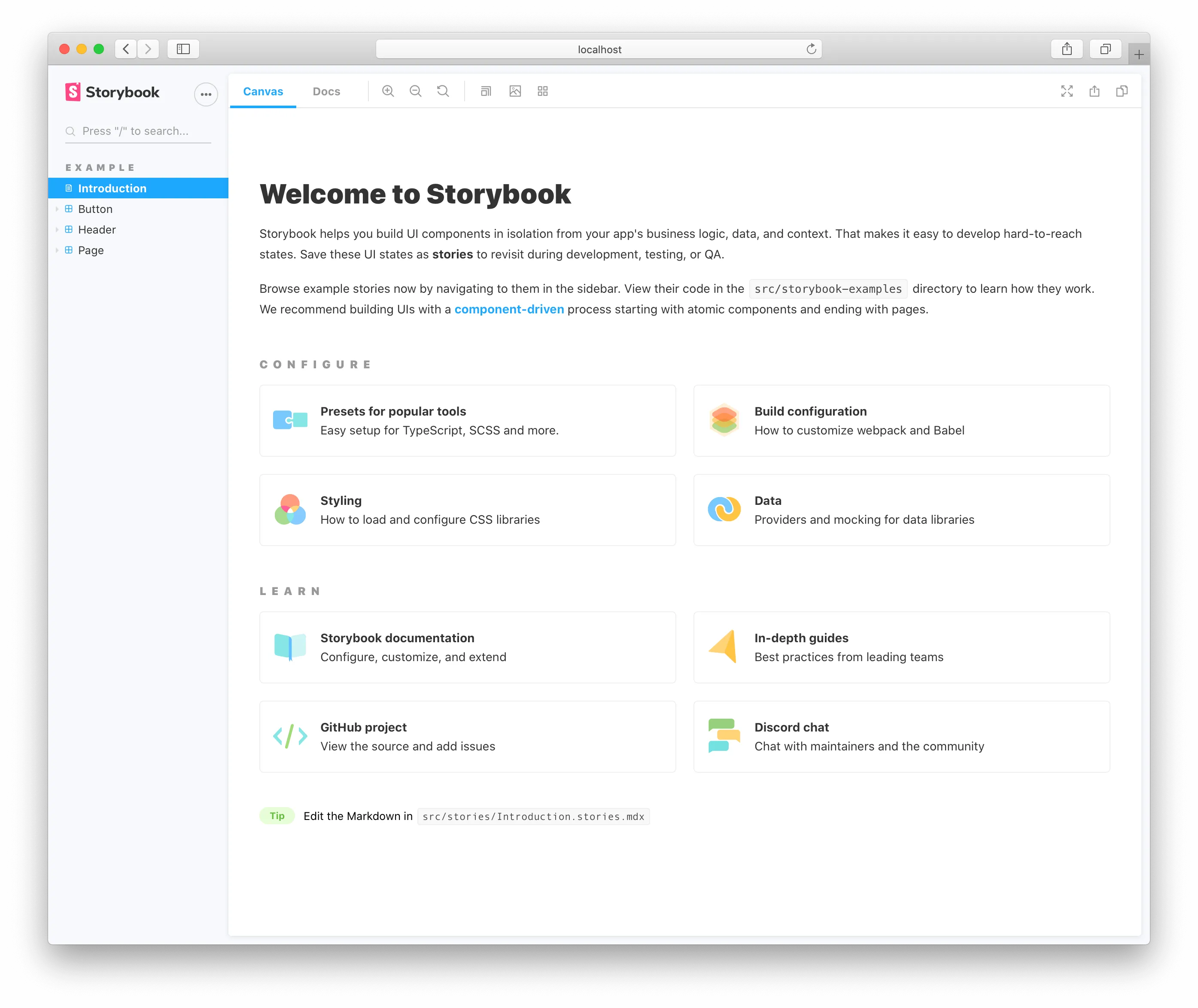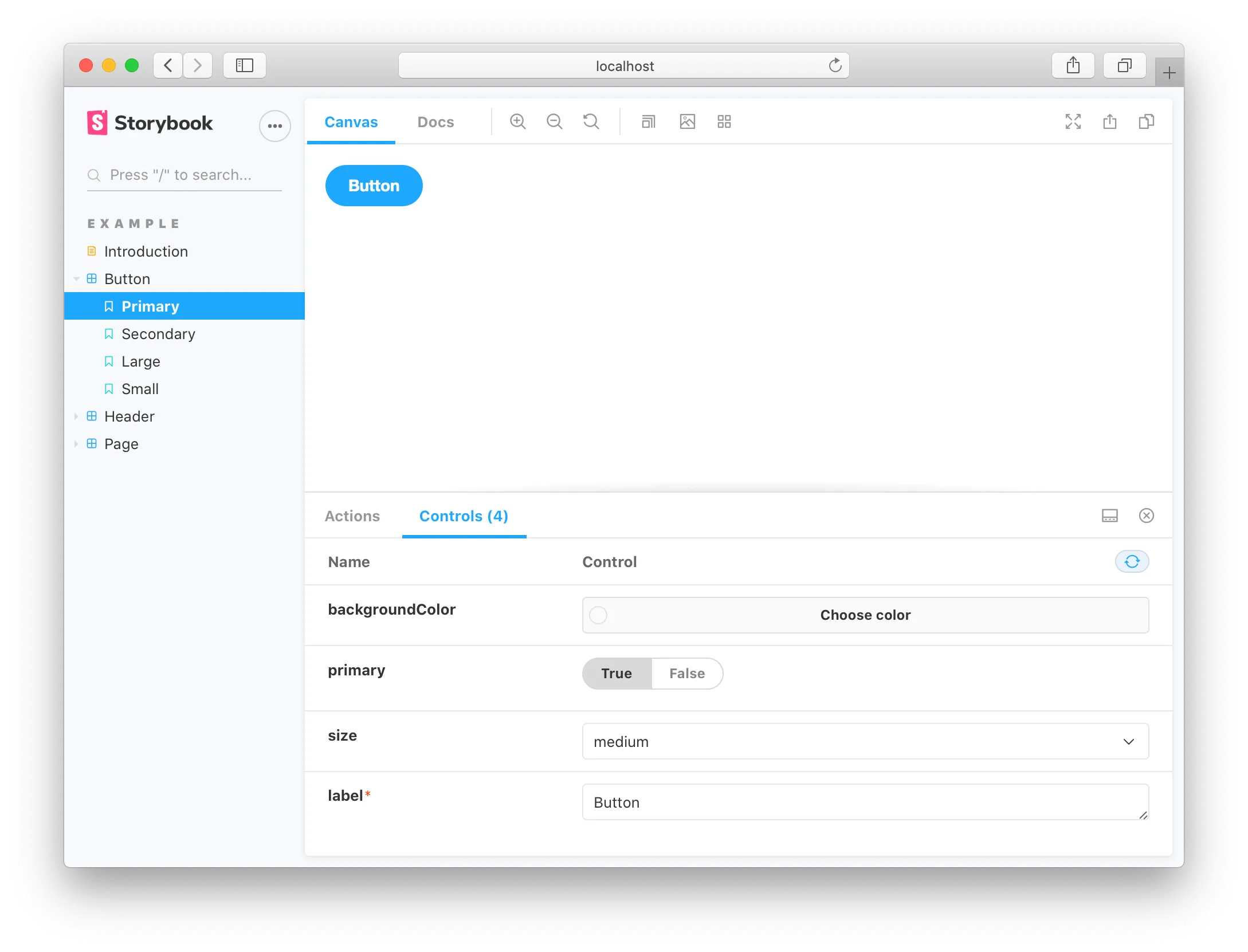什么是Storybook
Storybook 是一个用于UI开发的开源工具,通过隔离组件,使开发更快、更容易。它提供了一套完整的开发流程,你可以不用配置一个复杂的开发环境、不用和数据库交互,也不需要和你的应用程序关联。
Storybook可以帮你记录组件的文档,以便重复使用,并自动对你的组件进行视觉测试来防止出现bug。同时Storybook还有一个插件的生态系统来扩展自身的能力,如微调响应式布局或验证可访问性。支持多种前端框架,甚至目前还在进行试验性的支持服务端渲染组件框架。
当你启动执行 yarn storybook 时,会启动一个dev server,并自动在浏览器中打开一个页面,显示欢迎界面。

什么是 story
在Storybook中,一个story包含了一个组件渲染时的状态。开发者可以给一个组件写多个story。可以简单的将一个story理解成一个包含了组件特定状态的demo。可以在案例中看到,默认会展示Button,Header和Page三个例子。
在代码层面来看,一个.stories.js就是一个story。这个文件包含了渲染时的状态。最终也会在web中以一个单独的案例呈现。
// Button.stories.js
import Button from './Button.vue';
export default {
/* 👇 The title prop is optional.
* See https://storybook.js.org/docs/vue/configure/overview#configure-story-loading
* to learn how to generate automatic titles
*/
title: 'Button',
component: Button,
};
export const Primary = () => ({
components: { Button },
template: '<Button primary label="Button" />',
});

在我们的实际场景中,主要工作就是为每个组件编写story,以展示每个组件的不同能力
怎么写 Story?
组件的sotries是独立定义在组件文件之外的story文件。服务于开发环境,不会打包到项目中。
Button.js | ts | jsx | tsx
Button.stories.js | ts | jsx | tsx | mdx
在storybook中过,定义了一个称为 Component Story Format(CSF)的规范。一个基于ES6 模块的标准,方便书写,并且可以在不同工具间移植。在CSF中,关键部分是用于描述组件的默认导出和描述组件stories的具名导出。
两种导出方式
默认导出 Default export
默认导出的信息决定Storybook如何排列你的stories和addon使用的信息。例如,下面是一个Button.stories.js 的默认导出
// Button.stories.js
import Button from './Button.vue';
export default {
/* 👇 The title prop is optional.
* See https://storybook.js.org/docs/vue/configure/overview#configure-story-loading
* to learn how to generate automatic titles
*/
title: 'Button',
component: Button,
};
具名导出 Defining Story
具名导出一个单独的story。下面是导出一个叫做 Primary 的 story
// Button.stories.js
import Button from './Button.vue';
export default {
/* 👇 The title prop is optional.
* See https://storybook.js.org/docs/vue/configure/overview#configure-story-loading
* to learn how to generate automatic titles
*/
title: 'Button',
component: Button,
};
export const Primary = () => ({
components: { Button },
template: '<Button primary label="Button" />',
});
也可以通过 storyName 对 story 的名字进行修改
// Button.stories.js
import Button from './Button.vue';
export default {
/* 👇 The title prop is optional.
* See https://storybook.js.org/docs/vue/configure/overview#configure-story-loading
* to learn how to generate automatic titles
*/
title: 'Button',
component: Button,
};
export const Primary = () => ({
components: { Button },
template: '<Button primary label="Button" />',
});
Primary.storyName = 'I am the primary';
通过Args对象定义Story
所谓的一个story,是一个带有一组参数的组件,这些参数定义了组件应该如何渲染。在Storybook中,通过Args定义参数。Args是一个JavaScript对象,它可以用来动态地修改props,slot,样式、输入等。允许Storybook和插件实时编辑组件。
Args用法很简单,可以通过story实例的args设置为Story级别的参数,也绑定在默认导出对象上作为Component级别的参数。
Story 级别的Args只对绑定的story生效
// Button.stories.js
import Button from './Button.vue';
export default {
/* 👇 The title prop is optional.
* See https://storybook.js.org/docs/vue/configure/overview#configure-story-loading
* to learn how to generate automatic titles
*/
title: 'Button',
component: Button,
};
// 👇 We create a “template” of how args map to rendering
const Template = (args, { argTypes }) => ({
props: Object.keys(argTypes),
components: { Button },
});
//👇 Each story then reuses that template
export const Primary = Template.bind({});
Primary.args = {
primary: true,
label: 'Button',
};
Component 级别的Args,对组件下所有的Story生效。
// Button.stories.js
import Button from './Button.vue';
export default {
/* 👇 The title prop is optional.
* See https://storybook.js.org/docs/vue/configure/overview#configure-story-loading
* to learn how to generate automatic titles
*/
title: 'Button',
component: Button,
//👇 Creates specific argTypes
argTypes: {
backgroundColor: { control: 'color' },
},
args: {
//👇 Now all Button stories will be primary.
primary: true,
},
};
使用Parameters控制Story
parameters是与story有关的一组静态具名元数据,通常用来控制Storybook的功能和addon的行为。
和Args的使用方式类似,不过除了 Story 级别的 Parameters 和 Component 级别的 Parameters之外,可以在.storybook/preview.js 中定义 Global Parameter,作用于所有的story。
Story 级别的 Parameters
// Button.stories.js|ts|jsx|tsx
import { Button } from './Button';
export default {
/* 👇 The title prop is optional.
* See https://storybook.js.org/docs/react/configure/overview#configure-story-loading
* to learn how to generate automatic titles
*/
title: 'Button',
component: Button,
};
const Template = (args) => ({
// 👈 Your template goes here
});
export const Primary = Template.bind({});
Primary.args = {
primary: true,
label: 'Button',
};
Primary.parameters = {
backgrounds: {
values: [
{ name: 'red', value: '#f00' },
{ name: 'green', value: '#0f0' },
{ name: 'blue', value: '#00f' },
],
},
};
Component 级别的 Parameters
// Button.stories.js
import Button from './Button.vue';
export default {
/* 👇 The title prop is optional.
* See https://storybook.js.org/docs/vue/configure/overview#configure-story-loading
* to learn how to generate automatic titles
*/
title: 'Button',
component: Button,
//👇 Creates specific parameters for the story
parameters: {
backgrounds: {
values: [
{ name: 'red', value: '#f00' },
{ name: 'green', value: '#0f0' },
{ name: 'blue', value: '#00f' },
],
},
},
};
Global parameters
// .storybook/preview.js
export const parameters = {
backgrounds: {
values: [
{ name: 'red', value: '#f00' },
{ name: 'green', value: '#0f0' },
],
},
};
三种级别的Parameters优先级顺序依次是 Story Parameters > Component Parameters > Global Parameter。Parameters 只会合并,相同的键值会按照优先级覆盖,不会丢弃。
添加Decorators 包装 Story
所谓Decorators,可以在保持原有的 story 不变的情况下,额外给它添加额外的 DOM 元素、引入上下文环境、添加假数据等等。
和 Parameters 一样,它也可以定义在全局/组件/story 三个层级,每个 Decorator 按定义顺序依次执行,从全局到 story。
利用 Decorators,我们可以用额外的DOM包装Story的渲染结果,
// YourComponent.stories.js
import YourComponent from './YourComponent.vue';
export default {
/* 👇 The title prop is optional.
* See https://storybook.js.org/docs/vue/configure/overview#configure-story-loading
* to learn how to generate automatic titles
*/
title: 'YourComponent',
component: YourComponent,
decorators: [() => ({ template: '<div style="margin: 3em;"><story/></div>' })],
};
也可以提供一个独立的Context,将参数或者数据传给Story。
// .storybook/preview.js
import Vue from 'vue';
import { library } from '@fortawesome/fontawesome-svg-core';
import { faPlusSquare as fasPlusSquare } from '@fortawesome/free-solid-svg-icons';
import { FontAwesomeIcon } from '@fortawesome/vue-fontawesome';
library.add(fasPlusSquare);
//👇 Storybook Vue app being extended and registering the component
Vue.component('font-awesome-icon', FontAwesomeIcon);
export const decorators = [
(story, { args, argTypes, globals, hooks, parameters. viewMode }) => ({
components: { story },
template: '<div style="margin: 3em;"><story /></div>',
}),
];
同样的,像 Parameters 一样,Decorator 可以在全局、组件级别和单个故事中定义。当Story渲染时,所有与Story相关的Decorator将按以下顺序运行。
- Global Decorator ,按照它们定义的顺序
- Component Decorator,按照它们定义的顺序
- Story Decorator,按照它们定义的顺序
调用Play Function实现交互
Play function 在 Story 渲染完成后执行。可以实现与组件的交互,可用于测试需要交互的场景。它的的使用与前面提到的几个概念稍有不同,它的能力由几个插件组合提供,需要先安装好。
# With npm
npm install @storybook/addon-interactions @storybook/testing-library --save-dev
# With yarn
yarn add --dev @storybook/addon-interactions @storybook/testing-library
然后补充一些配置
// .storybook/main.js
module.exports = {
stories:[],
addons:[
// Other Storybook addons
'@storybook/addon-interactions', //👈 The addon registered here
};
下面是一个简单的例子,首先引入依赖,然后为Story添加Play方法
// RegistrationForm.stories.js
import { screen, userEvent } from '@storybook/testing-library';
import RegistrationForm from './RegistrationForm.vue';
export default {
/* 👇 The title prop is optional.
* See https://storybook.js.org/docs/vue/configure/overview#configure-story-loading
* to learn how to generate automatic titles
*/
title: 'RegistrationForm',
component: RegistrationForm,
};
const Template = (args) => ({
components: { RegistrationForm },
template: '<RegistrationForm />',
});
export const FilledForm = Template.bind({});
FilledForm.play = async () => {
const emailInput = screen.getByLabelText('email', {
selector: 'input',
});
await userEvent.type(emailInput, 'example-email@email.com', {
delay: 100,
});
const passwordInput = screen.getByLabelText('password', {
selector: 'input',
});
await userEvent.type(passwordInput, 'ExamplePassword', {
delay: 100,
});
// See https://storybook.js.org/docs/vue/essentials/actions#automatically-matching-args to learn how to setup logging in the Actions panel
const Submit = screen.getByRole('button');
await userEvent.click(Submit);
};
当 story 渲染完成后,play方法会自动执行。可以在Interactions面板中一步步查看流程。更多细节可以查看官方的详细介绍。
结束语
以上是Storybook的一些基本概念,按照文档走一遍,搭建出自己的组件库文档是没问题的。接下来会介绍如何更好地命名和组织组件的层级结构。